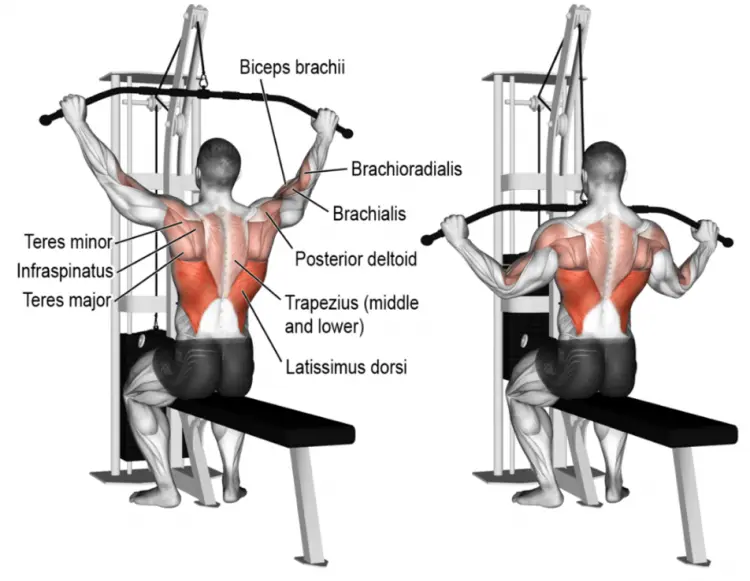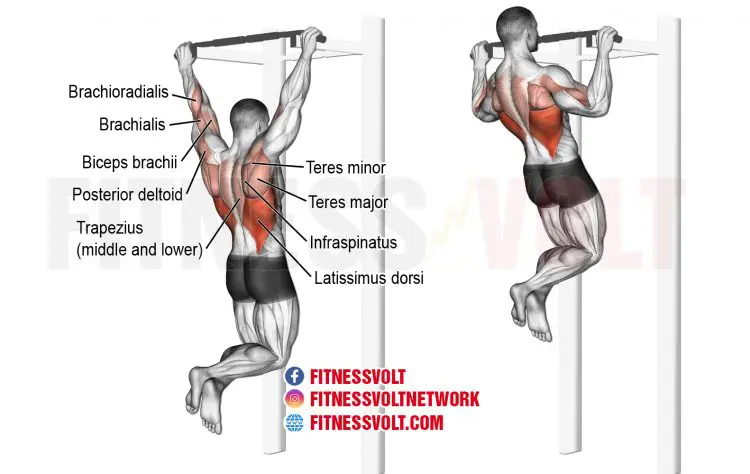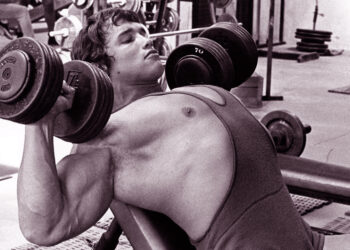Back training is a must if you want to be strong and muscular. A well-developed back can add a lot to your physique and make you stand out in a crowd.
A wide, dense back makes you look powerful and can be seen from not only behind but the side and even the front too. Strong back muscles are also important in many sports and physically challenging situations, like pulling an opponent off their feet or pulling yourself up a rope or over a wall.

While horizontal rows are a must for back training, vertical pulling exercises are important too. In fact, according to bodybuilders, it’s rows that give your back thickness, while vertical pulls are responsible for building width.
The two main vertical pulling exercises are lat pulldowns and pull-ups.
In this article, explore the differences and similarities of these two classic upper-body exercises and reveal some variations of each one so that you can choose the right one for your goals.
Lat Pulldown 101

The lat pulldown is something of a gym staple. Bodybuilders, fitness fanatics, and general exercisers all use this machine to train their back muscles. Lat pulldowns are a compound exercise, which means they involve two or more joints and several muscles working together simultaneously.
Level Up Your Fitness: Join our 💪 strong community in Fitness Volt Newsletter. Get daily inspiration, expert-backed workouts, nutrition tips, the latest in strength sports, and the support you need to reach your goals. Subscribe for free!
The main muscles involved in lat pulldowns are:
- Latissimus dorsi – the largest muscle of the upper back
- Teres major – the muscle at the bottom of your shoulder blade
- Biceps brachii – the front of your upper arm
- Posterior deltoid – the back of your shoulder
- Trapezius and rhomboids – the muscles across and between your shoulder blades
There are several different lat pulldown machine designs, including cable lat pulldowns and lever lat pulldowns, but they all work in more or less the same way.
How to do Lat Pulldowns
- Adjust the weight and then hold the bar with an overhand, slightly wider than shoulder-width grip. Sit down so your thighs are held in place by the leg restraints. Pull your shoulders down and back and lean back slightly, lifting your chest up toward the bar.
- Keeping your wrists straight, lead with your elbows and bend your arms, pulling the bar down to your upper chest.
- Pause in this most contracted position and then smoothly return to the starting position.
- Without relaxing your shoulders, repeat for the desired number of repetitions.
Lat Pulldown Pros
There are several reasons to include lat pulldowns in your back-building workouts, including:
Suitable for all levels of exerciser – lat pulldown machines have a selectorized weight stack, making it easy to change the weights. It doesn’t matter how strong (or how weak) you are; you should be able to do this exercise. In contrast, some bodyweight exercises are simply too hard for many beginners.
Easy to learn – lat pulldowns are a pretty straightforward exercise, and even training novices should be able to pick them up quickly. While it can be gratifying to learn a new exercise, it’s also nice to be able to get to grips with one after just a few minutes of use.
Minimal lower back stress – when it comes to lat exercises, there are two main movement patterns; horizontal pulls (rows) and vertical pulls (pull-ups and pulldowns). A lot of rowing exercises involve leaning forward at the waist, which can put a lot of stress on your lower back. For some exercisers, this stress is a problem. Lat pulldowns place very little pressure on your lower back and can even help stretch and decompress your spine. In short, lat pulldowns are very lower back-friendly.
Perfect for drop sets – take your back development to a new level by incorporating drop sets into your workouts. Drop sets are a training system where you reduce the weight as you near fatigue. This allows you to train beyond muscular failure, triggering greater muscle growth. Lat pulldowns are PERFECT for drop sets.
Several variations available – while lat pulldowns are often done using an overhand, slightly wider than shoulder-width grip, there are several similarly effective variations, including:
- Supinated or underhand grip lat pulldowns
- Narrow neutral grip lat pulldowns
- Parallel shoulder-width grip lat pulldowns
- Single-arm lat pulldowns
- Behind the neck lat pulldowns
Lat Pulldown Cons
Like every exercise, there are a few cons to using the lat pulldown too:
Limited availability – while most gyms have lat pulldown machines, if you work out at home or in a garage gym, you may not have access to a lat pulldown machine. They tend to be big and quite expensive, so even if you want one for your home gym, it may not be practical to get one. That said, it IS possible to do lat pulldowns using a resistance band and a good setup to ensure you’re overloading the muscles sufficiently.
Weight limit – train long enough and build enough strength, and you may outgrow lat pulldowns, especially if the machine you use only has a small weight stack. Once you can rep out the entire stack of weights on your lat pulldown machine, this exercise will lose some of its potency, and you’ll have to focus on doing more and more reps to challenge your muscles.
Pull-up 101
Pull-ups are another well-known back exercise. They’re a favorite among the military, where they are often used as a test of strength and muscular endurance. In recent years, pull-ups and other calisthenic or bodyweight exercises have enjoyed a resurgence in popularity, largely because they’re a staple of many CrossFit workouts.
Like pulldowns, pull-ups are a compound exercise and involve the same main muscles, namely:
- Latissimus dorsi
- Teres major
- Biceps brachii
- Posterior deltoid
- Trapezius and rhomboids
How to do Pull-ups
- Hang from a suitable overhead bar using a pronated or overhand grip, hands about shoulder-width apart. Pull your shoulders down and back, brace your abs, and bend your legs, so your feet are clear of the floor. Cross your ankles if you wish.
- Lean back slightly, lift your chest up toward the bar and bend your arms. Pull your chin up and over the bar.
- Smoothly extend your arms and repeat
Pull-up Pros
Pull-ups offer several notable advantages:
Minimal equipment required – you can do pull-ups anywhere you can find something suitable to hang from, including doorway pull-up bars, freestanding pull-up bars (power towers), power and squat racks, tree branches, and ceiling joists.
Find the best pull-up bars here.
Very functional – pull-ups replicate pulling your body up and over a wall or climbing a rope or rock face. As such, they are very functional.
Lots of overload – pulling your entire body weight up using just your arms is a significant feat of strength that will also help develop muscle size. You can make pull-ups more challenging by increasing your weight with a weighted vest, backpack, or chin/dip belt.
Several variations available – like pulldowns, there are several variations you can use to keep your pull-up workouts productive and interesting:
Level Up Your Fitness: Join our 💪 strong community in Fitness Volt Newsletter. Get daily inspiration, expert-backed workouts, nutrition tips, the latest in strength sports, and the support you need to reach your goals. Subscribe for free!
- Chin-ups – done with a supinated or underhand grip
- Neutral grip chin-ups
- L pull-ups – done with legs raised and parallel to the floor
- Weighted pull-ups
- Assisted pull-ups
- One-arm pull-ups
A useful fitness benchmark – the number of pull-ups you can do is a good indicator of your fitness and strength. That’s why the army, fire departments, and other organizations use them in their fitness tests. Doing your first pull-up is a significant achievement while doing 5, 10, 15, or 20 are all worthy goals to work toward.
Increased muscle activation – studies suggest that pull-ups produce greater muscle fiber activation than pulldowns (1). That’s because pull-ups involve pulling your body through space, which has a more significant impact on your nervous system. However, it’s worth noting that this difference is relatively small and may be negated if you cannot do a reasonable number of pull-ups to begin with.
Pull-up Cons
While pull-ups are largely safe and effective, there are a couple of disadvantages to consider too:
A challenging exercise – with pull-ups, you need to be strong enough to lift your entire body weight with just your arms. If you are very muscular, overweight, or not especially strong, this may not be possible, or you may not be able to do many reps. As such, pull-ups are often thought of as an advanced exercise. Women may also struggle with pull-ups as they tend to have less upper body muscle mass than men.
Form breakdown and kipping – some exercisers resort to swinging their legs to do pull-ups. In CrossFit, workout participants kick their legs on purpose to do more or faster reps, which is called kipping. In either situation, swinging and kicking your legs takes stress off the target muscles and increases the risk of muscle and joint injury, especially to the elbows, shoulders, and lower back.
Not ideal for high reps – while you can do lat pulldowns with low weights for high reps to develop muscular endurance, this is not possible with pull-ups where the minimum weight is your body weight. That said, there are ways to counteract some of your body weight, such as using an assisted pull-up machine or doing band-assisted pull-ups.
Lat Pulldowns vs. Pull-Ups
So, now that you know a little more about lat pulldowns and pull-ups, let’s judge these exercises by a few different criteria.
Lat Pulldowns vs. Pull-Ups: Convenience
If you train at a gym, you should have no problem doing lat pulldowns. Most gyms have at least one lat pulldown machine, and many have several because it’s such a popular exercise. However, that does mean you’ll only be able to do lat pulldowns when you go to the gym.
In contrast, as well as the pull-up bar at the gym, you can also do pull-ups at home, at the park, or anywhere else that you can find a suitable place to hang. Also, pull-up bars are usually relatively cheap, and there are models made specifically for home use.
Winner: Pull-ups
Lat Pulldowns vs. Pull-Ups: Hypertrophy
Pull-ups recruit more muscle fibers than lat pulldowns, which means they could help you build muscle a little faster. That said, with lat pulldowns, you can adjust the weight and use different rep ranges, training systems like drop sets to train your muscles past failure and use the variations to hit your muscles from different angles. As such, and despite the studies, lat pulldowns may be marginally better for hypertrophy.
Winner: Lat pulldown
Lat Pulldowns vs. Pull-Ups: Strength
Pull-ups involve lifting your entire body weight with just your arms. This is a significant load to put on your muscles, and that will make them stronger. You can use a weighted vest, backpack, or chin/dip belt to further increase your weight and build even more strength.
While lat pulldowns have heavy weight stacks, using more weight than you weigh is not easy. In time, you may also get so strong that the machine doesn’t offer enough resistance. For weaker people, lat pulldowns are an effective strength exercise, but pull-ups are arguably the better choice as you get stronger.
Winner: Pull-ups
Lat Pulldowns vs. Pull-Ups: Beginners
With less weight involved and a more straightforward movement, lat pulldowns are easier to learn and master than pull-ups. That said, if you use an assisted pull-up machine or resistance bands to counteract some of your weight, pull-ups get a whole lot easier. However, in terms of simplicity, lat pulldowns are better for beginners, although most exercisers should eventually be able to work up to doing at least a few pull-ups.
Winner: Lat pulldowns
Lat Pulldowns vs. Pull-Ups: Long-Term Progression
Unless you are using a plate-loaded machine, the resistance available for lat pulldowns is limited to the size of the weight stack. In contrast, with pull-ups, you start out with your body weight and can add lots more weight, ensuring you can make continuous long-term progress. There are also several more demanding pull-up variations, so you should never outgrow pull-ups. However, doing pull-ups over and over again could lead to a progress plateau.
Winner: Pull-ups
Lat Pulldowns vs. Pull-Ups: Safety
Unlike barbell bench presses and squats, there are no weights to drop on yourself during lat pulldowns or pull-ups, so you can train to failure in complete safety. Because pull-ups involve pulling your body off the ground, they are marginally more dangerous than lat pulldowns, but that said, most pull-up bars are set at a sensible height, so even if you do drop off the bar unexpectedly, you shouldn’t hurt yourself. In terms of joint stress, providing you are strong enough to do pull-ups properly, both exercises should be similarly safe.
Winner: It’s a draw!
Wrapping Up
Lat pulldowns and pull-ups are both great back exercises. They involve similar movements and affect the same muscles. In fact, in many ways, they are almost interchangeable.
However, the main difference is the weight involved. With pull-ups, your body weight is the resistance, which means they provide a challenging, intense workout from the get-go. In contrast, you can start much lighter with lat pulldowns. For that reason, it makes a lot of sense to begin lat pulldowns and progress to pull-ups as you get stronger.
That said, even if you are strong enough to do pull-ups, pulldowns are still a valuable exercise, and are a handy exercise to add to your workouts for keeping your training varied and productive.
In the battle between lat pulldowns and pull-ups, there is no clear winner, so do the one you like the best. Better still, do them both to enjoy all of the benefits these superb exercises have to offer.
References:
1 – PubMed:Kinematic and Electromyographic Comparisons Between Chin-Ups and Lat-Pull Down Exercises https://pubmed.ncbi.nlm.nih.gov/24245055/
Interested in measuring your progress? Check out our strength standards for Bench Press, Pull Ups, Chin Ups, and more.









